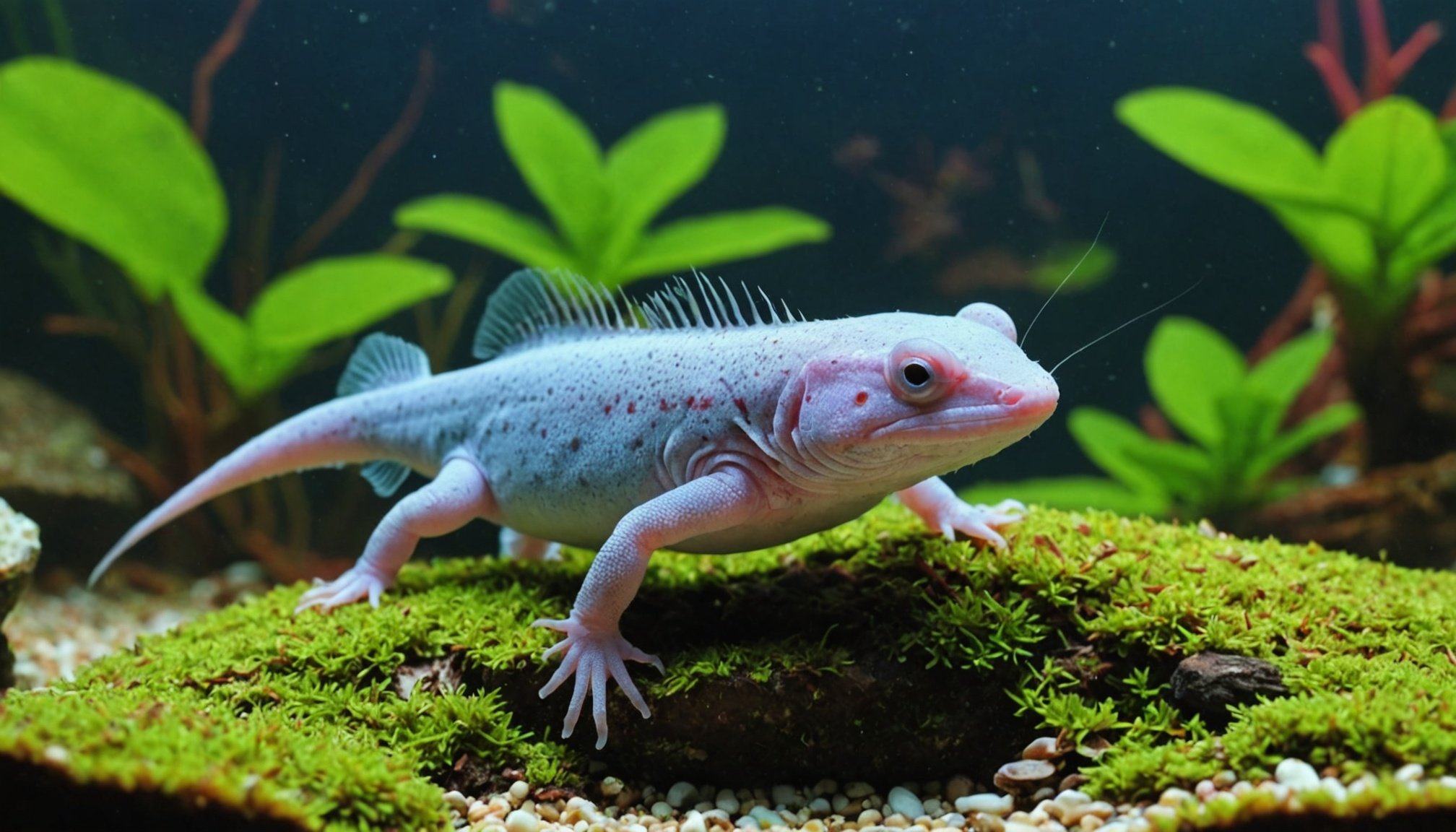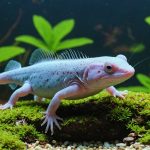Introducing an axolotl to your tropical aquarium can be exciting, yet challenging. These unique creatures have specific needs that differ from typical tropical fish. Ensuring compatibility requires careful consideration of tank conditions, water parameters, and potential tankmates. This guide offers essential tips for a successful cohabitation and helps you create a harmonious environment for both your aquatic friends. Get ready to enhance your aquarium experience!
Understanding Axolotl Habitat Needs
Exploring the essentials for a thriving aquatic environment
Avez-vous vu cela : Mastering Litter Box Training: Are Ferrets Capable of Success?
Essential Water Conditions
Axolotls thrive in specific aquarium conditions that mimic their natural habitat. Maintaining a consistent water temperature between 60-64°F is crucial. The aquatic environment should have low water flow to prevent stress. Regular monitoring of pH levels, ideally between 6.5 and 7.5, ensures a healthy habitat. A high-quality filtration system is essential to maintain clean water and prevent ammonia build-up.
Substrate and Decorations
Choosing the right substrate is vital. Fine sand is recommended, as it minimizes the risk of impaction if ingested. Avoid gravel, which can be harmful. Incorporating decorations like smooth rocks and plants can enhance the axolotl habitat. Ensure that all decorations are free of sharp edges to prevent injury.
Dans le meme genre : Unleashing the Long-Term Health Advantages of Agility Training for Your Yorkshire Terrier
Importance of Hiding Spots and Spacious Environments
Axolotls appreciate hiding spots for security. Use caves or PVC pipes to create safe spaces. A spacious aquarium allows for natural movement and exploration, promoting physical health. Aim for a minimum of 10 gallons per axolotl to provide ample room.
- Key Considerations:
- Temperature: 60-64°F
- pH Level: 6.5-7.5
- Substrate: Fine sand
- Space: Minimum 10 gallons per axolotl
Creating an ideal aquatic environment ensures the well-being of your axolotl, supporting their unique needs.
Compatibility with Tropical Fish
Exploring cohabitation possibilities with axolotls
Compatible Fish Species
When considering tropical fish compatibility with axolotls, it's essential to select species that are peaceful and non-aggressive. Suitable tank mates include guppies, white cloud mountain minnows, and zebra danios, as they exhibit calm behavioral traits. These species typically coexist without causing stress to axolotls.
Observing Behavioral Traits
Monitoring behavioral traits is crucial in ensuring harmonious cohabitation. Look for signs of aggression or territorial behavior, such as fin nipping or chasing. If these behaviors are observed, it may be necessary to separate the species to prevent harm. Always introduce new species gradually and observe interactions closely.
Risks of Aggressive or Territorial Fish
The presence of aggressive or territorial fish poses significant risks to axolotls. Such fish can cause stress, injury, and even illness. Avoid species like cichlids and bettas, known for their aggressive nature. Prioritize the well-being of your axolotl by choosing compatible and peaceful tank mates.
- Key Considerations:
- Peaceful species: Guppies, minnows, danios
- Monitor for aggression
- Avoid cichlids and bettas
By carefully selecting compatible aquatic species, you can create a harmonious environment that supports both axolotls and their tropical fish companions.
Water Parameters for Successful Co-Habitation
Ensuring optimal conditions for axolotls and tropical fish
Ideal Temperature Range
Maintaining the right temperature is crucial for both axolotls and tropical fish. Axolotls prefer a cooler environment, with a temperature range of 60-64°F. Tropical fish, however, often thrive in slightly warmer conditions. When cohabitating, aim for a compromise temperature of around 64°F to ensure both species remain comfortable.
Importance of pH Levels and Water Hardness
The pH levels of the aquarium should be closely monitored to maintain harmony. Both axolotls and many tropical fish thrive in a neutral pH level, ideally between 6.5 and 7.5. Additionally, consider the water hardness; softer water is generally preferable, but always check the specific needs of your chosen tropical species.
Regular Testing and Maintenance
Regular testing of water quality is essential to ensure a healthy environment. Utilize test kits to check pH levels, temperature, and water hardness consistently.
- Key Testing Parameters:
- Temperature: ~64°F
- pH Level: 6.5-7.5
- Water Hardness: Soft to Medium
By maintaining these water quality parameters, you can create a balanced and thriving habitat for your axolotls and tropical fish. Consistent monitoring and adjustments will help prevent stress and promote a harmonious cohabitation.
Dietary Considerations for Axolotls
Ensuring optimal nutrition for axolotls' health and growth
Types of Food Suitable for Axolotls
Axolotls require a specific diet to thrive. They are carnivorous, and their nutritional needs are best met with a variety of protein-rich foods. Suitable options include live or frozen bloodworms, earthworms, and small pieces of raw fish. Occasionally, high-quality axolotl pellets can be incorporated to provide balanced nutrition.
Feeding Frequency and Portion Sizes
Understanding the appropriate feeding guidelines is crucial. Young axolotls should be fed daily to support their rapid growth. Adults can be fed every two to three days. Always offer portions that can be consumed within 10-15 minutes to prevent overfeeding.
Avoiding Overfeeding and Dietary Imbalances
Overfeeding can lead to dietary imbalances and health issues such as obesity. It's important to monitor the axolotl's size and adjust the portion sizes as necessary. Regularly assess their diet to ensure it meets their nutritional needs without excess.
- Key Feeding Tips:
- Young axolotls: Daily feeding
- Adults: Every 2-3 days
- Portion: Consume within 10-15 minutes
By adhering to these feeding guidelines, you can maintain a healthy axolotl diet that supports their overall well-being.
Creating a Balanced Aquarium Environment
Ensuring harmony for axolotls and their aquatic companions
Incorporating Aquatic Plants
Aquatic plants play a vital role in creating a balanced ecosystem within an aquarium setup. They act as natural filters, absorbing excess nutrients and maintaining water clarity. Popular choices include Java moss, Anubias, and Hornwort. These plants not only aid in filtration but also offer hiding spots, enhancing the habitat for axolotls and their tank mates.
Maintaining a Balanced Ecosystem
A well-planned aquarium setup fosters a harmonious environment for all inhabitants. Ensuring a balanced ecosystem involves regular monitoring of water parameters and plant health. This balance supports the natural behaviors of axolotls and their companions, reducing stress and promoting overall well-being.
Benefits of Tank Mates
Introducing tank mates can further support a balanced ecosystem. Peaceful species contribute to waste management and algae control, enhancing the habitat's health. However, it's crucial to choose species compatible with axolotls to prevent aggression and stress.
- Key Ecosystem Elements:
- Aquatic Plants: Natural filtration
- Tank Mates: Waste management
- Monitoring: Regular checks
By incorporating aquatic plants and carefully selected tank mates, you can maintain a thriving aquarium setup that supports a balanced ecosystem for axolotls and their aquatic companions.
Monitoring Fish Behavior for Signs of Stress
Understanding and addressing stress in your aquatic environment
Recognizing Stress Indicators
Observing fish behavior is crucial for maintaining a healthy aquarium. Fish stress can manifest in various ways, such as erratic swimming, loss of color, or hiding excessively. Axolotls may show signs of stress through reduced activity or loss of appetite. Regularly checking for these behavioral signs helps in identifying potential issues early.
Importance of Interaction Monitoring
Monitoring interactions in the tank is essential for ensuring harmonious cohabitation. Aggressive encounters or constant chasing can indicate stress among tank mates. Pay attention to how tropical fish and axolotls interact, adjusting their environment as needed to reduce tension.
Adjusting Conditions
If signs of stress are observed, consider adjusting the tank conditions. This might involve altering water parameters, rearranging decorations, or providing additional hiding spots. Ensuring a balanced ecosystem can alleviate stress and promote well-being.
- Key Stress Indicators:
- Erratic swimming
- Loss of color
- Hiding behavior
By effectively monitoring fish behavior, you can create a stable and supportive environment that minimizes stress and enhances the health of your aquatic companions. Regular observation and timely adjustments are vital for maintaining a thriving tank.
Common Mistakes to Avoid in Co-Habitation
Avoiding integration mistakes for a harmonious aquarium setup
Overcrowding the Aquarium
A frequent cohabitation pitfall is overcrowding. Each species, including axolotls, requires adequate space to thrive. Overcrowding can lead to stress, aggression, and poor water quality, negatively impacting all inhabitants. It's essential to calculate the appropriate tank size based on the number and size of each species.
Ignoring Specific Needs of Axolotls
Another common error is ignoring the specific needs of axolotls. These unique creatures have distinct requirements that must be met to ensure their well-being. Failing to provide the correct water temperature, pH levels, and hiding spots can lead to health issues. Always prioritize the specific habitat needs of axolotls when planning tank integration.
Failing to Research Compatibility Thoroughly
Researching compatibility is crucial to avoid integration mistakes. Not all fish species can coexist peacefully with axolotls. Before introducing new tank mates, thoroughly research their behavioral traits, environmental needs, and potential impact on axolotls. This proactive approach can prevent stress and promote a balanced ecosystem.
- Key Errors to Avoid:
- Overcrowding
- Ignoring axolotl needs
- Inadequate compatibility research
By being mindful of these cohabitation pitfalls, you can create a harmonious and thriving environment for axolotls and their companions.
Establishing a Routine for Care and Maintenance
Ensuring consistent health and vitality in your aquarium
Importance of a Maintenance Schedule
A regular care routine is essential for maintaining a healthy aquarium environment. Establishing a consistent maintenance schedule helps ensure the well-being of all inhabitants. Regular checks prevent issues before they become serious, fostering a thriving aquatic ecosystem.
Regular Water Changes and Filter Checks
Conducting regular water changes is a cornerstone of effective aquarium maintenance. Aim to replace 20-30% of the water weekly to maintain optimal conditions. This practice removes harmful toxins and replenishes essential nutrients. Additionally, filter checks are crucial. Clean or replace filters as needed to ensure efficient removal of waste and debris.
Monitoring Health and Growth of Inhabitants
Closely monitoring the health and growth of your aquarium's inhabitants is a key aspect of the care routine. Look for signs of illness or stress, such as changes in behavior or appearance. Regularly assess the size and growth rates of your fish and axolotls to ensure they are thriving.
- Key Maintenance Tasks:
- Weekly water changes: 20-30%
- Filter checks: Clean or replace regularly
- Health monitoring: Observe behavior and growth
By adhering to a structured maintenance schedule, you can create a stable and healthy environment that supports the longevity and vitality of your aquarium's inhabitants.
Tips for Successful Integration of Axolotls
Guiding strategies for harmonious cohabitation
Gradual Introduction Techniques
To achieve successful integration of axolotls with new tank mates, employ gradual introduction techniques. Start by placing the new fish in a separate container within the main aquarium. This allows both axolotls and new companions to acclimate to each other's presence without direct contact. Over several days, gradually increase interaction time.
Observing Initial Interactions
Close observation of initial interactions is crucial during the integration phase. Watch for signs of stress or aggression, such as chasing or hiding. If any negative behavior occurs, reassess the cohabitation strategy. Adjust the environment by adding hiding spots or rearranging decorations to alleviate tension.
Adjustments During the Integration Phase
Making necessary adjustments during the integration phase can prevent issues. Monitor water conditions closely, as changes can affect both axolotls and their companions. Implement a transition strategy by slowly adjusting water parameters to accommodate all species.
- Key Integration Tips:
- Gradual introduction
- Monitor interactions
- Adjust environment
By following these cohabitation tips, you can ensure a smooth transition for axolotls and their new tank mates, fostering a peaceful and thriving aquatic environment.
Resources for Further Learning
Enhance your understanding of axolotl care with these valuable resources
Recommended Books and Guides
For those eager to deepen their knowledge of axolotl care, several well-regarded books provide comprehensive insights. Titles such as "Axolotls: Care and Breeding in Captivity" offer detailed guidance on maintaining a healthy aquarium environment. These resources cover everything from dietary needs to habitat setup, making them indispensable for both beginners and seasoned enthusiasts.
Useful Online Forums and Communities
Engaging with online aquarium communities can be incredibly beneficial. Platforms like Axolotl.org and Reddit's Axolotl subreddit are vibrant spaces for sharing experiences and advice. Here, enthusiasts discuss everything from water parameters to cohabitation strategies, providing a wealth of educational materials.
Local Aquarium Clubs and Expert Consultations
Joining local aquarium clubs offers the chance to connect with fellow hobbyists and gain firsthand insights. Many clubs host events and workshops, offering access to expert consultations. These gatherings are excellent opportunities to learn about the latest aquarium community trends and techniques.
- Key Resources:
- Books: "Axolotls: Care and Breeding in Captivity"
- Online Forums: Axolotl.org, Reddit
- Local Clubs: Workshops, expert advice
By exploring these axolotl care resources, you can significantly enhance your knowledge and create a thriving environment for your aquatic companions.











